Storm sewer calculation: analysis of important design features
A technical structure designed to collect and drain rain (melt) water is called a storm drain.This is one of those important structures for economic and technical purposes that are among the integral elements of residential, commercial, and industrial buildings.
An important factor during construction is the calculation of storm drainage. The construction of the system “blindly” risks flooding or drying out landscape areas, as well as destruction of the soil structure.
In the article we presented, the types of storm drains are analyzed in detail and the methods of their construction are described. The basic principles of designing atmospheric water drainage systems are outlined. Valuable recommendations for construction are given.
The content of the article:
Classification of types of storm drains
The practice of constructing various types of structures shows the use of three types of systems, each of which differs in the methods of collecting and removing precipitation products:
- Based on open channels and trays (ditch).
- Based on closed wells and pipelines (closed).
- Based on a combined solution (mixed).
The first project is implemented in practice by constructing canals that connect drainage trays to each other and, ultimately, drain the collected water beyond the intended territory.
All these elements of storm drainage have an open connection with the environment. The construction of such structures requires a relatively small amount of resources and materials.
The closed-type storm sewer system should be considered more advanced in design terms. Hidden drainage lines are being built here, as well as a system of storm water inlets - special intermediate storage tanks.
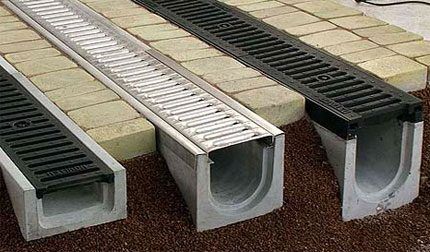
The collected water is discharged through networks of pipelines laid and hidden underground. As a rule, the collected products of atmospheric precipitation are discharged to treatment facilities and then into the waters of natural reservoirs.
The third option is mixed storm sewer. It is constructed on the basis of mounting components designed for both open and buried systems.
The design of mixed storm sewerage is carried out based on the rationality of operating the system in individual areas of the area. The financial side of its implementation plays an important role in the decision to choose a combined option.
Separately, a ditch (trough) system for collecting and draining rainwater should be highlighted. This storm drainage system, together with its simple manufacturing scheme, is characterized by universal operation.

Thanks to the ditch design, it is possible to organize not only quite effective drainage of precipitation products. The same system can be successfully used as an irrigation structure, for example, for the needs of a household (dacha) farm.
What is taken into account when calculating?
For each private construction project (exploited area of the territory), the design of an individual storm drainage schemes is commonplace.
However, the basis is always taken to be solutions typical for standard stormwater construction projects. Typical solutions by default involve resorting to technical calculations before the construction of the system begins.
Calculations are carried out with an eye to SNiP and taking into account the following factors characteristic of a specific area and object:
- annual precipitation rate;
- soil properties;
- object area;
- mass of discharged water;
- required drainage area.
In addition to information about the mass of sediment discharged, other information can be obtained by contacting the local weather service. And the conditional amount of discharged precipitation products is calculated using the formula, where the area of the drainage area and the parameter of the intensity of this precipitation are taken as calculation data.
Mathematical form of the formula:
M = (A * 20) * S * k,
In it accordingly:
- M – mass of discharged water;
- A – intensity of precipitation within 20 minutes;
- S – drainage area (for the roof also + 30% of the total area of the building walls);
- k – coefficient of moisture absorption by the object material.
The materials of the object are often roofing coverings (k=1); concrete and asphalt structures (k=0.9); soil (k=0.75); crushed stone, gravel (k=0.45).
System design features
Atmospheric precipitation is removed from the roof of the building through rainwater collection system. These are external lines of riser pipelines placed under the end points of the receiving gutters. In turn, receiving gutters are mounted along the perimeter of the roof area under the lower edge of the covering.
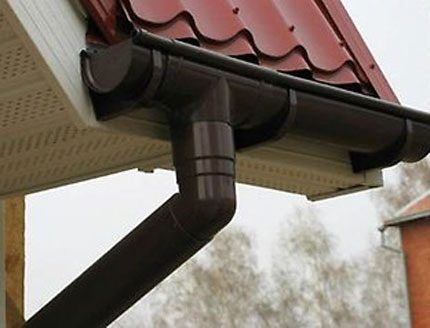
On flat roofs, the drainage goes directly into the pipe risers. With this scheme, drain pipelines are usually mounted vertically inside buildings, and their upper sockets are brought out onto the roof and are integral with the roofing carpet. On flat roofs of private houses, the presence of one drainage funnel is permissible.
If the house uses internal risers with an open outlet, their design must provide for the possibility of draining melt water into the domestic sewer system in winter. The drain line must be equipped with a water seal. Based on the calculated data on the consumed mass of water, the diameter of the pipes for the construction of the storm sewer riser is selected.
Table for selecting pipes for the riser:
| Pipe diameter, mm | 85 | 100 | 150 | 200 |
| Weight of rainwater, l/s | 10 | 20 | 50 | 80 |
The preferred material for internal drain pipes is plastic, asbestos cement, cast iron. Tin and plastic pipes are usually used to construct an external storm drainage system.
When installing horizontal trunk lines, it is required to maintain a standard slope (not less than 0.005 m and not more than 0.15 m per 1 m of line length).
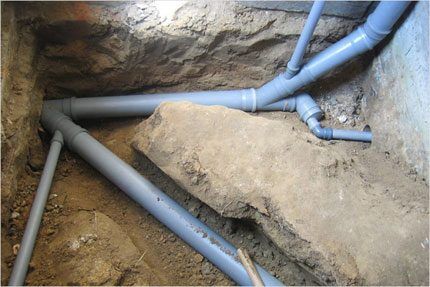
In case of maintenance, it is necessary to provide for the installation of inspections and cleanings. On storm sewer risers, audits are installed within the boundaries of the lower floor of the building.
In order to calculate the throughput of linear storm drainage trays, you need to take into account the area of the object being processed, the amount of slope towards the canals and the water absorption coefficient adopted to cover the territory. In addition to these data, you will also need to calculate the hydraulic cross-section of the tray.
General principles for arranging a storm drain
Owners of private houses are quite capable of constructing communications for collecting and draining rain (melt) water with their own hands. After completing all the calculations and purchasing the required materials, they begin to arrange the storm drainage system.
The first step is to dig trenches for drainage lines in the local area, according to the planned plan. Trenches are brought to the locations of drain risers (drainpipes). For planning a private household system, a trench depth of 300-500 mm is sufficient.
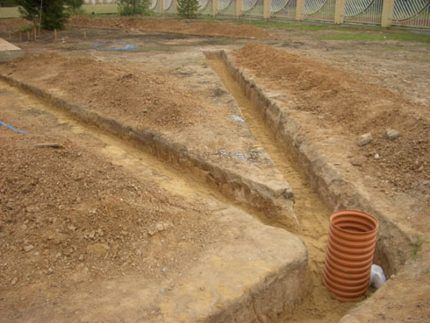
On sites under drainpipes, pits are dug for storm water inlets and installed. These system elements are rectangular containers of small volume (5-10 liters).
For the installation of inspection and rotary wells, it is recommended to use ready-made industrial plastic containers or make cast ones from polymer concrete. The first option is more expensive, but easier to install and maintain.
Industrially produced storm water inlets are usually supplemented with large waste collection baskets. Natural debris inevitably ends up in storm drains with rainwater flows.
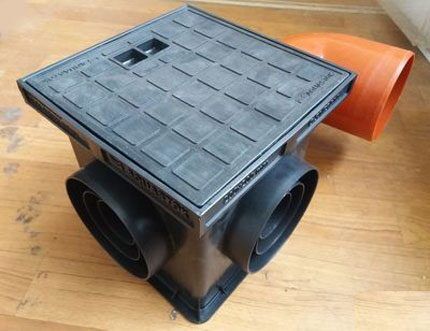
Based on the chosen technology for constructing storm sewers (open or closed), trays are laid in trenches or a line of polymer pipes.
If you are making a simple tray drainage system with outlet to a nearby lawn, it is advisable to consider the risks of possible soil erosion in the drainage areas. Elements of closed installation at joints must be sealed.
The communications collected in this way must be connected to a common storage tank or collector of a centralized network.
You should also take care of constructing sand filters immediately before entering the common storage tank. And don’t forget to install inspection wells. Their installation is necessary on sections of highways longer than 10 meters, as well as in places in the diagram where turns in the drainage line are formed.
Methods for discharging collected water
A serious task for owners of suburban real estate is the drainage of rainwater collected from the total area of the site.
If there are no centralized communications near the house, there are two options left to solve this problem:
- Collection in a special tank and subsequent use for irrigation;
- Discharge of water from the reservoir into the ground or into natural areas.
The first option is considered rational, provided that there are watering facilities on the territory of the house. In this case, you will need a simple device (a household pumping station) to pump water from the storage tank and then supply it to the irrigation areas.

The second option is accompanied by great difficulties. Removal into the ground is a time-consuming process. How long it takes to hatch depends on the soil’s ability to absorb moisture. In different relief areas, the coefficient of soil saturation with moisture can differ significantly.
In order to divert the storm sewer product to natural areas (“to the relief” or “to the landscape”), an additional scheme will have to be implemented. This scheme includes a central reservoir and a groundwater treatment system, for example, filter field.
The “relief” or “landscape” output scheme is accompanied by difficulties in constructing treatment modules. Both options require approval from environmental authorities.
Usually, the owner of the property (plot) has to contact the following organizations with the subject of approval:
- Department of Natural Surveillance.
- Fisheries Department.
- Office of Consumer Regulation.
- Basin and water management.
- CGMS.
The subject of approval means “Draft standards characterizing the discharge procedure.” Based on such a project, a permit is issued allowing the discharge of pollution “onto the landscape” or “on the relief”, and a decision is made on the provision of a water body.
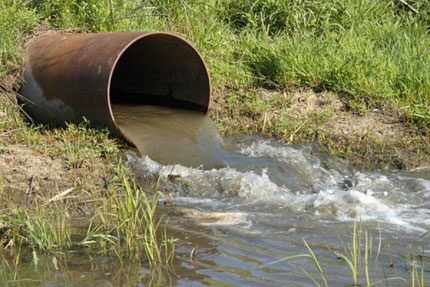
Implementing such options illegally carries the risk of high fines, and legal disposal requires approval from the authorities.
Private real estate projects traditionally include other communication networks along with storm drainage. Domestic sewerage and drainage system are also part of household communications. The principle of their operation differs little from the functioning of storm drains, in which owners of private houses often see the possibility of using these networks.
Meanwhile, the combination of storm sewerage with a domestic sewerage drainage system is prohibited by SNiP. The ban on combining different types of sewage systems is due to obvious factors.
Thus, provided that rainwater is discharged into the domestic sewer system and taking into account the high intensity of precipitation, the normal level of sewerage is increased several times.
Flooding of working wells leads to blockage of household and fecal wastewater. Mud deposits and natural debris flow into the domestic sewage system. As a result, after the next rainstorm, the organizers of the structure will have to clean the system.
Combining a storm drain with a sewer main threatens to result in disastrous results. Overflow of the drainage system due to violation of the design loads leads to flooding of the building foundation.
Frequent flooding disrupts the structure of the soil, which causes displacement of foundation blocks, erosion of the foundation under a monolithic structure, and in the future can lead to the destruction of the building.
Conclusions and useful video on the topic
Useful videos will expand your horizons about the purpose and installation of storm drains.
Video #1. Storm drainage in a private house - from design to installation:
Video #2. Industrial technologies:
The stages of design and careful calculation of storm drainage are an integral part of the construction of private houses. A carefully thought-out storm drain design and accurate calculations mean the durability of the structure and a comfortable environment for its inhabitants.
Would you like to tell us about how you installed a storm drain on your own summer cottage? Would you like to provide useful information and post photos on the topic of the article? Please write comments in the block below.




I cannot but agree with the author of the article, since the correct calculation of the storm sewer design determines the success of further operation. How many times have I encountered this when designing drains for a country house, but in the end I literally drowned in the accumulated liquid. But experience comes with time. Through short experiments, a positive result was nevertheless obtained.
A very serious approach. In principle, everything is clear and competent. Only my situevina is not quite ordinary. Private house within the city. There is no city sewerage. There are no vacant lots and generally no free space for water drainage. There are only 3 acres of land near the house. The cesspool is clearly insufficient in volume to collect water from the entire site. Maybe someone can tell me what to do in this case?
Good day, Andrey.
There should be a drainage ditch running along the road into which the storm water is diverted. If it is missing, you should definitely contact the district administration to arrange it. They are legally obligated to do this.
If they refuse for any reason, for example the common one: the absence of a ditch in the drainage scheme, then the administration must develop it. If you refuse, you file a lawsuit to impose an obligation to develop this scheme.
While the proceedings are ongoing, you can get out of the situation using the old effective method. Set up a boundary around the perimeter of the site, which previously acted as a fence familiar to everyone today.
The boundary is a ditch approximately 20 by 20 cm. Permission from government agencies or neighbors is not required for its arrangement. The area of a plot of 3 acres is roughly 18*18 meters; when converted to cubic capacity, it turns out that the boundary can take 3 cubic meters of water at a time.
The construction of boundaries is also resorted to in the case of high groundwater.